'Kríti very nice. Jámas!'
To get to know the real Crete, you have to go there in Spring
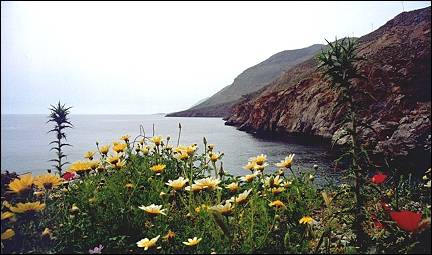
|
When the snow starts melting off the mountain peaks, Crete is in bloom and peace and quiet still reign. The best time to explore the real Crete, before its natural beauty is withered and mass tourism takes over the island. An introduction to Crete and its hospitality during a 500 miles bicycle trip.
Travelogue & photos: Piet de Geus
Iráklio
North-Crete
Pa-ra-ko-ló, she says, slowly and emphatically, while she serves a retsína and a bíera. Ef-cha-ríes-to, two voices answer from behind a "Greek for Travelers" guide. After arriving in Iráklio after dark, we took the first hotel we found on the main street and now, around midnight, we are sitting in the lounge of Hotel Astorion. We've got three weeks, enough time to leisurely bicycle across Crete. The female bartender helps us pronounce our first Greek words. Around one o'clock, when we return to our room, our kaliníechta already sounds practised.
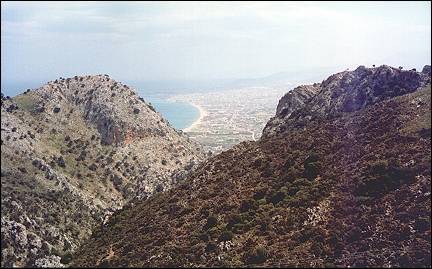
|
Outside the open doors of our balcony shines the Cretan Sea in the warm Spring sun. To the right is the airport, to the left the city and behind it the mountains we're going to conquer after breakfast.
In Gázi, just outside Iráklio, it's time to plunder a bakery; sandwiches with goat cheese, rolls with a sweet poppy seed stuffing, cake drenched in honey and gallons of cold water to fill our water bottles with are the spoils. The Greek appear to have a sweet tooth, making Crete a paradise of supplies. A little later we throw ourselves, energized, at the rocky incline of the 2400 feet high Stroúmboulas.
But the real mountain goats, which jump from rock to rock high above the road, make us look silly. When, after 10 miles, we spot a tabérna, we don't need to consult each other. Panting, we collapse in chairs on the terrace. Between two mountains we still can see Iráklio and the sea, way down below.
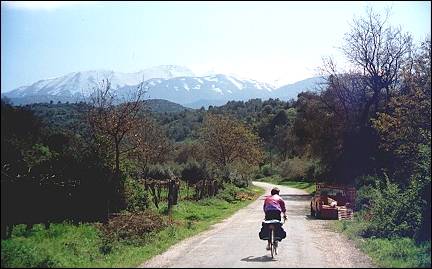
|
After an almost imperceptible rise until Damásta the road descends in bends into the narrow Geropótamos Valley. Bare rocks make place for green hills, tiredness and sore legs for euphoria: we glide effortlessly past men on donkeys and old women picking herbs on the sides of the road.
When we get off our bikes for the umptiest time because another flock of sheep is blocking our way, we see in the distance, behind the orange trees and huge cactuses, the white peaks of the Ída Mountains. Despite the haziness which still hangs over sunny Crete in April, it is an impressive view.
Hanía
North-West Crete
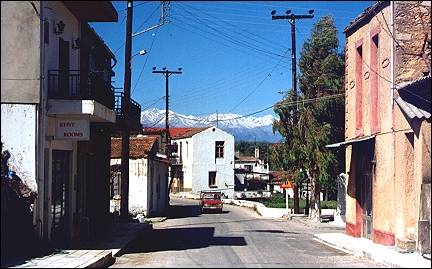
|
While we are still swallowing the last bites of our grilled swordfish, the owner of the restaurant puts a large plate with apple and orange slices on the table. Compliments of the restaurant. He sits down with us and pours three glasses of ice cold ráki.
'From Kríti, very nice,' he explains. 'Jámas!'
When we left Réthimno this morning, a town with Venetian fortifications and charming narrow streets with shops and terraces, and had to start with a mean climb, we were tempted to take the New Road with its smooth surface. But our decision to take a left turn onto a snaking country road is amply awarded: the sweet scent of broom flowers caresses our noses and the sun-bathed white peaks of the Lefká Óri Mountains appear to the left, then to the right and then again straight ahead of us. Winding our way through quiet mountain villages, we rarely have to go back to lighter gear.
Between the foothills lie fertile coastal plains with forests and orange groves. Behind those we can see the sea far below us. In the late afternoon we climb the Zoúrva, with its 1830 feet the last substantial hill before we reach Hanía. In the green valley below us, the villages get smaller and smaller. Especially Néo Horió emitted an atmosphere of peaceful quiet: a few dozen old men were sitting in the shadow of the kafeneíon and under the trees on the other side of the street, drinking coffee and playing with their worry beads.
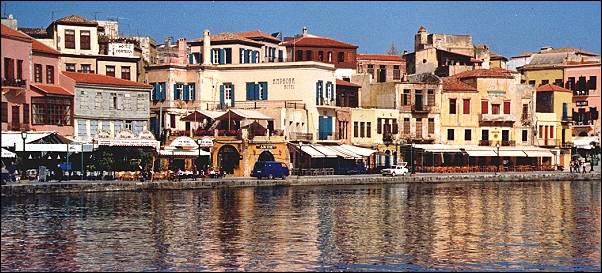
The signs old city lead us directly to the narrow streets of Hanía's Venetian Quarter, where we find a room above a little restaurant at 300 feet from the port. We rinse the dust of our 52.5 miles trip and start exploring. The old port is breathtaking, from the pier with the lighthouse and the arsenals where in the past the galleys were docked to the centuries-old buildings with terraces along the intimate promenade.
On our way back through the Venatian labyrinth we hear live music everywhere from inside restaurants and courtyards. An old neighbor just arrives, drunk. Under the amused gaze of the whole street, his wife puts him in a chair in front of the house.
While our host, in his best English, lists everything that is very nice apart from the ráki, he fills our glasses again and again for another round on the house. 'Beach very nice. Hanía very nice. Kríti music very nice. Food very nice. Everything very nice. Jámas!' Meanwhile, our drunk neighbor is snoring peacefully in his chair. We also need to turn in, before it gets much too nice.
Hóra Sfakíon
South-West Crete
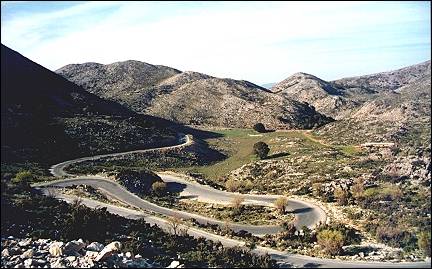
|
An old man, sitting at a table on a terrace, a handkerchief on his weahter-beaten head and his wide pants tucked in high boots, is having a conversation with the papás. On the pier, men are loading big blocks of ice in small wooden fisher boats.
Apart from this, nothing happens in the few streets at the foot of a hundreds of feet high mountain wall. When we order coffee and cake, the waiter disappears in an alley next to his establishment.
Yesterday morning, in the sweltering heat, we climbed the road from Hanía to the top of a rugged hill. When we entered Maláxa at 1500 feet, a spirited old man jumped in front of our bikes with his arms wide open. A robbery? No,another example of uninhibited Cretan hospitality: we were taken to the terrace of his tabérna where we were offered coffee and water and were invited to read a stack of old calendars full of stories from earlier guests.
In '91 lots of English, who fought the Germans here 50 years ago, visited this place. And many, many tourists appear to have been taken off their mopeds on the only crossing in this hamlet, to be taken to the terrace and filled up with home-made ráki. Gesturing that we will fall off our bikes, we succeed in limiting ourselves to half a glass each. He puts a plate of walnuts next to our glasses. How does this man make a living if his guests are only allowed to pay for the coffee and in exchange for the rest only have to write something in an old calender?
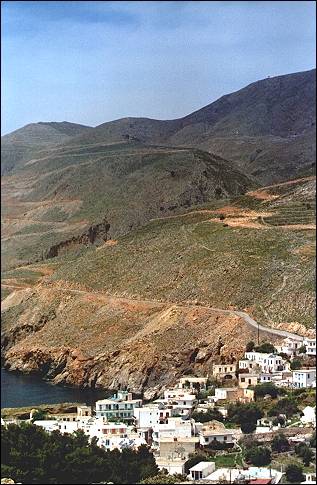
|
After we left Maláxa we made a spectacular descent with hairpin bends down a hill that was yellow with flowers and shrubs. In Vrísses began a 30 miles long pass over the Lefká Óri to Hóra Sfakíon on the South shore. It started as an imperceptible incline, but soon we had to push our pedals hard in the sweltering heat without even the slightest breeze.
At an altitude of 1800 feet, we sit down, dripping with sweat, at an isolated road restaurant, causing great hilarity in the young waiters. Watching a truck pass by, we understand why: in the next bend, the truck starts growling dangerously, creeping up a steep hill. After another bend in the road, it has become a small dot. With our luggage and 42x28 as lightest gears, we'll never make it. The only option is to fill our water bottles to the rim and walk the worst part.
In comparison with the English, who in 1941 had to walk the whole distance we bicycle today, shot at by planes and with the Germans at their heels, it was a relaxed walk through a desolate area. From a distance the impressive, rocky peaks seemed bare, but close by they turn out to be covered in flowers, fragrant herbs and shrubs. And of course the ubiquitous goats and sheep.
At an altitude of over 2700 feet the road leads us over the Askífou plateau along groves and a few hamlets. All over Crete, it apparently is a favorite passtime to shoot at traffic signs, but here even the names of the villages have become illegible because of the impact of bullets. When we reach the South-side of the plateau, a straight road along a mountain ridge stretches before us; to our left is the 900 feet deep Imbrof Canyon. At the end of the canyon we get our first view of the Libyan Sea, 2100 feet below us. A little later the road dives downward in dizzying hairpin bends.
When we're almost at the foot of the hill, it's already dark and potholes and stones make it hard to bicycle, so we walk the last few of the 60 miles we travelled today. Judging by the lights that shine scattered on the hillside, Hóra Sfakíon seems a pretty town. Next morning, by daylight, as the waiter brings us a tray full of freshly baked cakes from the bakery, that impression in confirmed. The coffee, by the way, is on the house.
Agía Galíni
South Crete
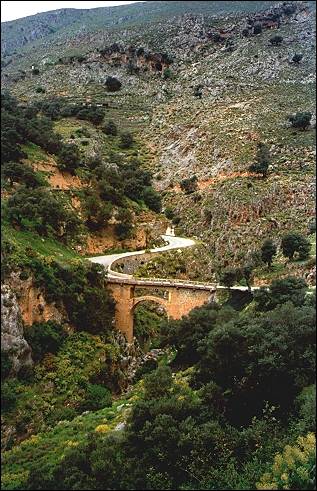
|
By the end of the morning we walk underneath overhanging rocks to the beach. Steel nets are have been suspended along the walls of rock to prevent falling stones from hitting beach-goers on this narrow path. The cold water is exhilirating. The construction workers who are pouring concrete behind the beach to prepare outdoor cafes for the coming tourist season, also flee the heat every now and then for a dive in the sea.
Accompanied by the sound of singing from churches, yesterday in Marioú we entered a diminutive coffee house for our first coffee of the day. Without asking, the young owner with his charming smile not only served us two glasses of water with our coffee, but also two little glasses of ráki, with the meanwhile well-known motto: it's tasty, because it's from Crete.
While our sober stomachs turned, the shy waiter peeled some raw broad beans for us to go with the ráki. It would have been rude to reject his proud hospitality, but as a precaution we drank our coffee first and payed, so he wouldn't have a chance to refill our glasses. Jámas, we said, while running out the door. Sometimes you have to be tough to be able to bicycle in Crete.
The road along the South coast runs along the foothills of the Lefká Óri mountains, back to the foothills of the Ída. The sun has forced the snow on the peaks in retreat over the past week. Where the green of the hilly North shore was alternated every now and then by rocky inclines, here, on the mountainous South shore, the rocks are every now and then bisected by green valleys with rivers. Only the canyons are really bare, everywhere else flowers are in bloom, daisies and broom; higher up thyme and oregano spread their scents. Here and there we even see olive groves on the steep hillsides. And everywhere on the roadside is a rustling of lizards, which sometimes even show themselves.
The day before yesterday the road followed the coast more or less from hillside to hillside, but yesterday it turned land inward along the Kourtaliótiko Canyon. Between the bare rocks that rose up high to the right of the road, a deep chasm opened, its grey-black walls covered in grit and rocks. By the end of this menacing canyon, all of a sudden a lovely green river valley appeared, through which the road lead to Spíli. There we filled our water bottles with ice-cold springwater from one of the 19 lion heads on a Venetian fountain.
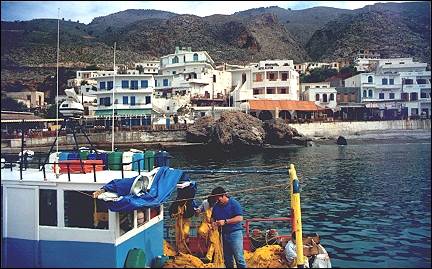
|
After one of those pesky inclines along a few villages, the road started climbing seriously over the rocky hillsides of the Kédros til 1500 feet. After that, there was a long descent back to the shore. Judging by the rocks that were scattered on the road, the warning signs for falling rocks are no joke.
The road took a turn around the foothills of the Vouvála and all of a sudden we found ourselves bicycling in the narrow streets, lined with hotels, of the former smugglers' harbour Agía Galíni, hemmed in between vertical walls of rock.
While we were paying for our meal on a roof terrace, we heard music from the street below us. It was a song by the Belgian band Vaya Con Dios. All right, we'll have one drink. Of course, we had more than one. The barkeeper practiced his Dutch with us for a change. The inevitable "gezellig" ("cozy") he already knew, as well as "lekker koud" ("nice and cold"), as we found out when he drew a lager. Of course his first question was whether we liked Crete and if we didn't agree that his village was the most beautiful place on the island. Every Cretan has the unshakable belief that his village is the best, but still wants to hear that confirmed by every tourist.
He kept the bottle of ráki, with which also this Cretan offered us his friendship, within reach. If he agreed with something, if the conversation threatened to die, if someone made a joke - the occasion didn't really matter - he grabbed the bottle and pronounced a toast: Jámas! By the time he had added "spaaknippelsleutel" (Spoke Nipple Wrench) to his Dutch vocabulary, we already had decided to spend the next day on the beach to recover from his hospitality.
Mírtos
South-East Crete
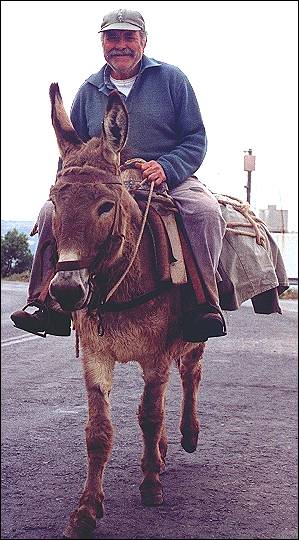
|
The sea splashes against the quay, two fresh cups of steaming-hot coffee sit on the table. The waiter is looking for his neighbor, who rents out apartments. When they return, they have picked some branches with ripe medlars for the guests. Patiently they explain that Holland, as a flat country, is suited for bicycling, but that Crete is mountainous and therefore better suited for travelling by car.
Yesterday was a relaxed day. After a steep climb leaving Agia Galíni we bicycled over the slightly hilly Messará plain. There was enough time to visit the Minoic archeological sites in Féstos and Górtina. On this island European civilization was born around forty centuries ago. We had to fill our water bottles in every village we passed on the way, because the soft breeze felt like a föhn and caused aerial vibrations over the plain with its fields of wheat, vines and olive trees, surrounded by the Ída and coastal mountains. The Southern winds arrive directly from the Sahara: Crete is farther South than African cities like Tunis, Algiers and Tanger.
We spent the night above the bakery of Pírgos, a hamlet at the end of the plain, that only came to life in the dusk, when people returned from their work on the land: by then, stores opened, the barber started cutting hair, cafes and restaurants filled with people. A buzz of voices and the smell of roasted meat spiced up the dark streets.
When the villagers rode their donkeys to the fields early this morning, it was also time for us to mount our bikes again. Just as we left, a bus full of Swedes overtook us. Near the village of Mártha, a triumphal arch of blossoming mimosa marked the beginning of our ascent on the side of the Díkti, Crete's third highest mountains, with peaks above the 1.5 miles. On the rocky incline we saw the Swedes again, this time on bikes. A few offered us nice amounts of money if we wanted to trade our bicycle-hiking shoes for their bicycle shoes: the ascent lasts for 7.5 miles and is rather demanding.
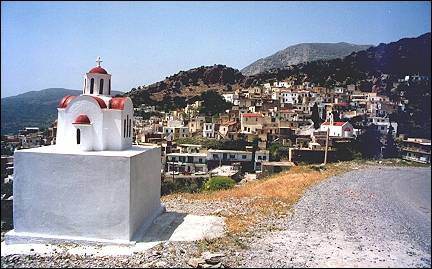
|
In Áno Viános, a picturesque mountain village with rustic tabérnas in the national colors blue and white, we found part of the Swedish group drinking beer. So it came as no surprise that during the last section of the route to the top at 3000 feet, the Swedish bus was filled with people who'd dropped out.
But they missed out on the reward for the climb: a long and beautiful descent to the sea. The road was not great, but you have to be careful anyway during a descent in Crete: even if the asphalt is new, it is sparsed with grooves for irrigation of the fields, and there always is a risk of loose chippings and crumbling road sides. But if you stay alert, it is totally doable. We didn't even get punctures in our 20 mm tires. After 15 miles the road descended into Mírtos and lead us to the promenade, where a waiter helped us find a room for the night.
Ístron
North-East Crete
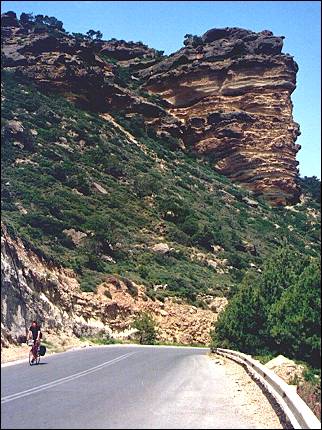
|
Before dinner in Ístron we drink a glass of oúzo. It warms us, but when we look back at the clouds from which we just descended, we start shivering again.
It took us two days of bicycling to get around the Eastern point of Crete. From Mírtos to Ierápetra the surroundings were dominated by sometimes decrepit plastic greenhouses and along the next stretch of the coastal road it was demonstrated what developers can do to the Mediterranean: it was hard to find the original villages between the patchwork of vacation homes. Still, every now and then we passed by a typical white church or found ourselves riding beneath impressive rock formations.
The surroundings became really impressive when the road turned land inward towards Sitía on the North shore. Within 7.5 miles it ascended along the driest hillsides of the island to 1500 feet. Deep down below us birds of prey were stalking birds even deeper below. From there we descended over 15 miles between olive trees, until we reached the port of Sitía, where we easily found a place to spend the night in one of the charming streets
When we left Sitía the next morning, the road immediately started ascending to 1500 feet. After a short while, there was no other traffic than a lone donkey every once in a while. To the left of the cypress-lined road were deep valleys with terraces. For the first time it was cold. It didn't rain, but it was humid; cloud after cloud descended from the high ridge toward us.
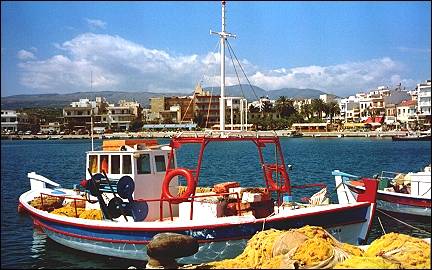
|
In the hamlet Hamézi we discovered behind an open door a dark little cafe, its walls covered with posters that were yellow from old age: coffee! As a welcome one of the three men who were having a discussion at the only table shouted that we were his guests.
A woman with a flowery apron filled glasses with water for us from an old jerry can and brought a plate of almonds and raisins with our coffee. In a corner sat a crooked old woman, who tried to start a conversation with us. It turned out that she was deaf, and the others didn't succeed in explaining to her that we didn't speak Greek. While we bicycled out of the village, we still could hear the whole company shouting at her that we were toeriestíe from Olandíja.
After another climb the road was all of a sudden lined with high bushes of blossoming broom. Between two peaks the road descends 600 feet to Méssa Moulianá, where the sun broke through. Immediately we craved yoghurt with honey. When we ordered it in a cafe, the waiter took two plates with Greek yoghurt into the garden. When he got back, he told us that there had been no more honey, so he went to the bee hives and cut open a comb above our plates. The traditonal yaoúrti me méli never before tasted this good.
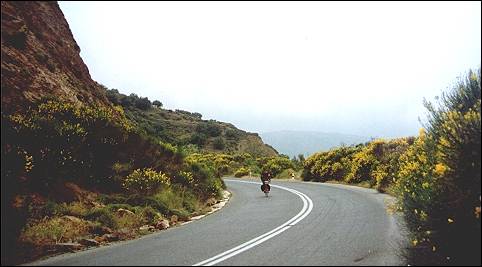
|
After a 600 feet climb, the road continues over the cold mountain sides of the Orinó.
To our right the canyon-like abyss of the Akrotíri Mirabéllou yawns and deep down below us the Cretan Sea. Parts of the sea were bathed in sunlight; we looked up to see where the wholes in the thick layer of clouds were, forgetting that we weren't biycling beneath, but in the clouds. The sides of the road were pink with blooming succulents.
From Platános a straight road descended in a few miles 1200 feet along the side of the Thriptí to sea level. Every 300 feet we descended, added a few degrees to the temperature. In Ístron it was even warm and sunny. The white clouds were only hanging around the peaks of the mountains.
Vathianós Kámbos
North Crete
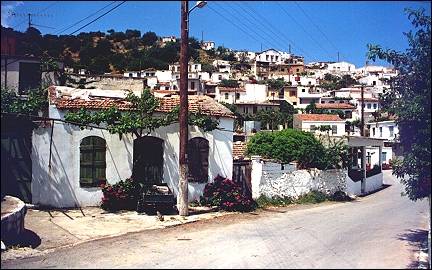
|
Babís unscrews the cap of the old Coca Cola bottle and fills our glasses. He just told me that someone in his village distilled the ráki from grape sediment. It's the best on the island.
We don't contradict him, no more than we did with all the others who said exactly the same thing about their anonymous bottles in the past few weeks. As far as we're concerned, all of them were right: jámas!
As we reached the North shore at Síssion, we ordered two double Greek coffee with lots of sugar, in fluent Greek: Parakoló dhio kafé Ellinikó váris glykós diplós. The blond waitress didn't understand us: she was Swedish.
After three weeks of peace and quiet we find ourselves in the part of Crete that is completely exchangeable with Torremolinos or Mallorca. Every year, two million tourists spend their vacations here. And that shows: it's one hotel and apartment development after another. Tourist shops, money change offices, car and motorbike rentals, noisy bars and even gambling arcades. It's only April and it is already unpleasantly crowded and noisy. In Hersónissou, the absolute lowest point, there is even a traffic jam of brightly colored buggies and 4-wheel drives. The one bright spot is that this has opened the Cretans' eyes: in other places on the island high rises are not allowed and building has to be done in local style.
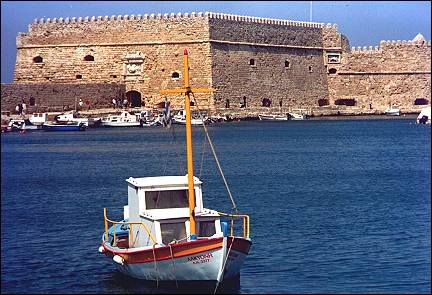
|
Babís, the manager of a small apartment complex in Vathianós Kámbos where it still is a little quiet, produces with his dark voice the opening sentence that is used by all Cretans: Welcome, do you like Kríti?
He has the matching proud look and the typical form of hospitality: the inevitable bottle in his hand. How far into the season is he going to be like this? He has a tired look when he thinks about the economically necessary evil that soon will wash over his Kríti again. Full of melancholy he speaks about his little village in the mountains. But he quickly recovers and fills the glasses again: 'Jámas!'